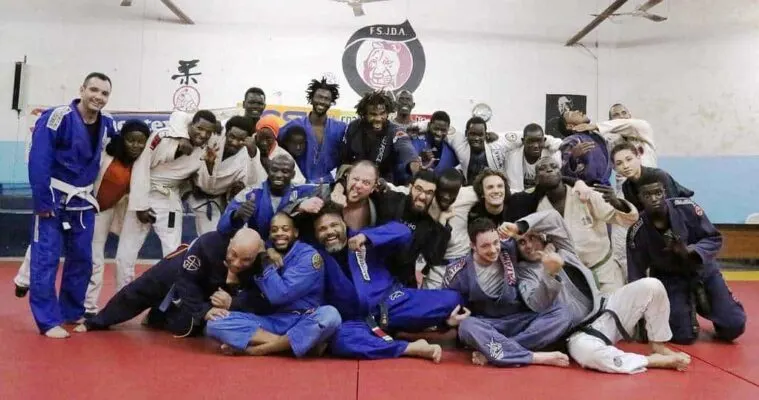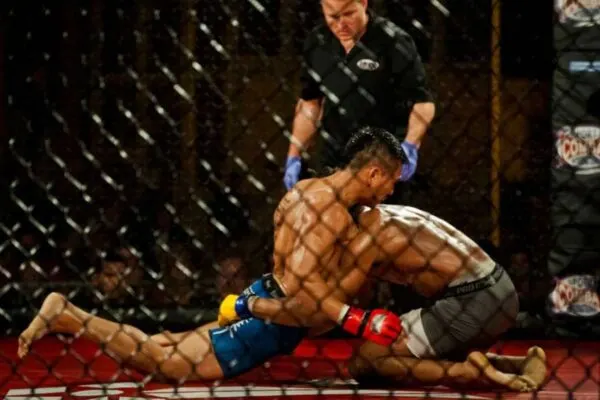
Editor’s note: The views and opinions expressed below are those of the author.
Due to its efficacy in real-life situations and the increasingly popular mixed martial arts world, Brazilian Jiu-Jitsu (BJJ) is not just the fastest-growing martial art in the world but one of the fastest-growing competitive sports too.
As Brazilian Jiu-Jitsu gains more popularity, the cost of joining a BJJ gym has increased significantly. This has made many people reconsider if paying such a high price to learn BJJ is truly worth it.
In this article, we explore the value of learning Brazilian Jiu-Jitsu. We’ll analyze the costs and benefits, as well as potential alternatives or more affordable training options to consider.
Why Am I interested in Learning BJJ?
Whether or not you should train in Brazilian Jiu-Jitsu, regardless of the cost, depends on a number of things. As with any hobby, or career path, you should first ask yourself – seriously, why am I pursuing this?
For one, the main reason might be because it is an effective martial art that can be pressure tested through live sparring, with significantly less risk of life-altering injury or brain damage than striking arts.
Although it is not always favorable to take a fight to the ground, particularly if you are facing multiple assailants or if you think your attacker is armed, a huge percentage of real-life combat situations will end up on the ground. Due to this high risk, it’s better to know how to defend yourself in this scenario.
Also, taking an opponent to the ground means you have a good chance of controlling them when they are there without causing injuries which might incur lengthy court cases, financial damage, or even sentencing.
Second of all, Brazilian Jiu-Jitsu is fun. This is in part due to the techniques and the training being mentally stimulating but also fun. It is also in part due to the comradery, team spirit, and competitive environment which it can inspire.

Thirdly, it’s a great exercise that engages many muscles and can stimulate cardiovascular health. Couple this benefit with the fact that exercise, particularly when around encouraging teammates, can also inspire better dietary habits.
Why Is BJJ so Effective?
One of the main reasons BJJ is so effective is because it emphasizes the use of leverage and technique over physical strength and power, meaning that even a practitioner that is diminutive in stature can take on a larger opponent if they’re sufficiently trained enough.
Another reason BJJ is so effective is that it is a grappling-based martial that focuses on ground fighting techniques. Due to the high percentage of real-world fights which end up on the ground, being highly trained in grappling techniques such as joint locks, chokes, and submissions puts the trained person over an untrained one.
As BJJ practitioners have live sparring rounds, they’re able to pressure test their understanding of these moves in a controlled environment.
Another big factor is that as BJJ is both physically and mentally demanding, it builds the users’ mental and physical toughness. The mental toughness can allow the user to feel more focused in high-pressure scenarios, while physical toughness can reduce the chance of long-term damage.
As for its use in MMA, Jiu-Jitsu is evolving all the time as martial artists attempt to come out with new techniques and strategies to counter old ones and the movements of other martial arts. This adaptability allows BJJ users to stay ahead of the curve and to handle the ever-changing landscape of mixed martial arts.
RECOMMENDED READING: What is Submission Wrestling? A Guide for Beginners
Why Is BJJ so expensive?
There are many reasons why BJJ classes may be expensive in your area. Gyms have various overheads such as rent, employees insurances and utility bills, which only seem to increase in price every year.
When it comes to high quality instruction, BJJ “professors”, sometimes appear to charge a lot of money. In some instances, this may, again be profit-focused, but it is worth noting that anyone who gets to a black or brown belt level in the art has had to invest a lot of time and money into the sport themselves.
Becoming a BJJ black belt typically takes ten+ years of dedicated studying and practicing, sometimes sacrificing time that could be spent on other things for time on the mats. For this reason, many Jiu-Jitsu practitioners don’t get past the blue belt rank and either stagnate or don’t get past this level.
Therefore, it appears that charging a high fee for Brazilian Jiu-Jitsu lessons is simply a matter of economics. Fewer black belt instructors are available to teach than people who want to learn. As such, these instructors can charge higher fees due to their expertise and high demand for learning.
People Who Benefit Greatly from BJJ
Brazilian Jiu Jitsu is an art that can be taken up by people from all walks of life and is suitable for almost all ages, genders, and levels of fitness. As with any art, there are various groups who will find studying BJJ more useful. These include the following:
Law Enforcement, Security Services, and Military
Police officers, security guards, bodyguards, and various members of the armed forces may find BJJ incredibly beneficial. Those working in these professions may be prone to violent attacks that require them to defend themselves while often showing a level of restraint.
Jiu-Jitsu is a martial art that enables practitioners to subdue attackers without causing excessive harm. This makes it particularly useful for law enforcement personnel who must adhere to the use-of-force policy required by a court of law, where they are only allowed to use reasonable force based on the totality of the circumstances.
When it comes to military personnel, the United States Marine Corps (USMC) has recognized the effectiveness of BJJ in close combat scenarios. BJJ emphasizes the use of leverage and technique over brute force, making it effective for military personnel, such as in peacekeeping operations where non-lethal combat techniques are very useful.
Mixed Martial Arts (MMA) fighters
BJJ is an incredibly popular martial art with MMA athletes. Grappling techniques and submissions have proven to be highly effective time and time again in the cage.

Even if Brazilian Jiu-Jitsu isn’t the main focus of a fighter, they can still use it as a form of counter-grappling in order to get back to their game plan. For instance, a striker may use BJJ to protect themselves from a wrestler if they are taken to the floor of the octagon or ring.
Individuals Who Want To Protect Themselves
BJJ, like any practical martial art, is designed for the user to protect themselves in real-life encounters. Whether you are at risk of being bullied or have to walk through a dangerous area at night, having techniques designed to neutralize an attacker and give you the opportunity to escape can be incredibly beneficial.
It is worth noting that almost all good self-defense teachers will teach the value of situational awareness and a good sprint. Fighting should, in almost all given circumstances, be the last resort.
Women Who Want to Protect Themselves
Following on from the previous point, women may want to learn BJJ as the techniques eschew power and strength for leverage and technique. BJJ can empower women with confidence knowing that they have some skills that can offer them greater protection.
People Who May Not Find BJJ Worth it
While training BJJ yields a plethora of benefits, there are various groups of people who may not find it worth the cost.
Those Who Can’t Afford It
Depending on your location and the schools in proximity, BJJ training may be prohibitively expensive. Membership fees, gis, rash guards, shorts, and mouthguards can add up to a fairly costly shopping list. Having all these items can make it difficult for various individuals to afford them.
People with Health issues
Although BJJ is fairly injury-free compared to striking arts such as boxing, Muay Thai, or even contact sports such as football or rugby, injuries can still happen. Additionally, existing injuries can be further aggravated.
Those with underlying health conditions like heart or respiratory issues may find BJJ to be too demanding on the body. The strain placed on the body may not be suitable for those with these health conditions.
If you have existing injuries or conditions, it’s worth checking with a physician before you take up any new exercise routine.
Those Uncomfortable With Human-to-Human Contact
One saying often heard in Jiu-Jitsu circles is “get comfortable being uncomfortable.” This is because grappling can feel strange and unnatural for those training for the first time. Rolling with an experienced grappler has been compared to “drowning on dry land.”
Most beginners practicing Jiu-Jitsu have to find a way to overcome this unpleasant feeling and become more calm and centered on the mats.
Suppose you feel like you might not be able to overcome the anxiety of body-to-body contact, which a grappling martial art entails but still want to improve your self-defense capabilities and fitness. In that case, a stand-up martial art such as kickboxing or karate may be a better option.
How Long Does it Take to Become Proficient in BJJ?
The amount of time required for Jiu-Jitsu to be effective as a form of self-defense will vary from person to person, depending on their age, level of fitness, ability to pick up and assimilate new movements, frequency of training, the coaching they receive, and the type of training involved.
That being said, if someone trains consistently at least twice a week for a couple of months, they will already start to see big improvements in their capability to defend themselves. While you can usually safely assume that someone with a black belt in BJJ is sufficiently well-equipped to handle a one-on-one confrontation with an unarmed attacker, you do not need to be a black belt to be effective in a real-world encounter.
Additionally, anyone who trains in Jiu-Jitsu for some period of time and gets promoted should be wary not to become overconfident. As the winner of the inaugural UFC tournament, Royce Gracie, once said: “The belt only covers two inches of your a*s, you have to cover the rest.”
To be effective in self-defense scenarios, jiu-jitsu practitioners should spend time going over fundamental techniques – basic sweeps, escapes and the types of submissions which can neutralize an assailant while offering a low risk of being slammed onto the concrete floor. In this last instance, standing guillotines can be great. Learning how to properly control an attacker as you wait for assistance is important.
RELATED: How Long Does it Take to Learn BJJ for Beginners? Q&A
Cost Associated with Learning BJJ
As with any new past times, sport, or hobby, it is beneficial to know the costs involved.
BJJ Class Fee
The most obvious cost of BJJ would be the membership or class fees. Many BJJ schools ask that you pay a monthly membership fee, while some will even ask for several months in advance.
This will vary depending on the location and quality of the school. In the US, for instance, this may range from around $120-$250 per month, while in the UK, this may average from around £60-80.
Purchasing a Gi or uniform
The second most obvious cost of BJJ is for the uniform. There are two main types of BJJ classes: gi and no gi. Gi training involves wearing the traditional garb – a gi or kimono, virtually identical to the clothing used in judo. No-gi training is usually conducted in shorts, a t-shirt, or a rashguard (effectively a skin-tight long-sleeve t-shirt).

Credit: Cleber Satoshi Takeuchi
Not every BJJ practitioner trains in the gi, as many are more focused on developing a skill set more suitable to mixed martial arts, or they don’t enjoy the intricacies involved with training in the gi – such as lapel chokes, or a type of defensive position known as spider-guard. If you’re one of those practitioners, they only need to invest in half decent sport shorts, or MMA shorts, which can cost around $50, or less, depending on where you live.
Those that train in Gi can expect to pay around $100 to $200, depending on the quality and brand. Generally speaking, you’ll only need one or two gis, but it’s important to wash them after each use to maintain good hygiene. Some schools have their own Gis or other apparel, which they may charge at a premium price, and wearing them may be required for students.
Protective Gears
Another highly recommended piece of equipment is a gum shield or mouth guard. Low-end ones will cost around $20, but if you are particularly concerned with protecting your teeth, you can have a dentist design a specially-made one. Also, purchasing a protective cup is highly recommended to protect private areas.
Conclusion: Are There Any Cheaper Alternatives to BJJ?
Suppose attending classes or being a member of a school is too expensive, but you still want to learn BJJ. In that case, you may want to consider some alternatives.
There is a wealth of BJJ information on YouTube, which you can use to learn all manner of techniques, ranging from submissions, escapes, guard passes, etc. Some of the most successful BJJ competitors and world-class BJJ coaches, such as John Danaher, even have DVD series showing their game plans.
But suppose you want to learn in person. In that case, it may be worth contacting BJJ instructors directly and seeing if they can accommodate your financial situation. Some schools have discounts for student members and may be willing to pass that on to you.
And some schools offer a daily pass system where you only pay for the classes you attend instead of a higher monthly fee. Here’s an unconventional way to learn if you can’t afford to pay a monthly fee but pay for a daily pass a few times or less in a month.
At home, you can focus on doing essential solo BJJ drills like shrimping or bridging, which are fundamental movements utilized in jiu-jitsu techniques.
Learning BJJ techniques is much easier if you master BJJ drilling movements. This enables you to quickly learn new BJJ techniques and make the most out of your in-class learning experience, especially if you can’t afford to attend classes regularly. You can find plenty of helpful solo BJJ drill videos on YouTube.
Various BJJ gyms will have open mat sessions, which may be free or cheaper than attending a class. You get to roll with experienced practitioners to learn from their expertise.
Lastly, other grappling martial arts may be cheaper to train. Learning judo, wrestling, or Russian sambo will give you some great self-defense skills and techniques similar to those used in BJJ. All of these martial arts are all options, and depending on where you are may have lower fees for the class.
